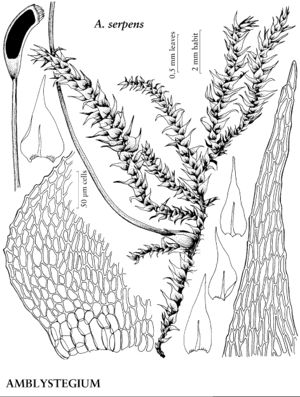Amblystegium
in P. Bruch and W. P. Schimper, Bryol. Europ. 6: 45, plates 561–566, 568–573. 1853.
| Taxon | Illustrator ⠉ | |
|---|---|---|
 | Amblystegium serpens | Patricia M. Eckel |
Plants small, green to yellowish. Stems freely and irregularly branched; hyalodermis absent, central strand present; paraphyllia absent; rhizoids or rhizoid initials on stem or abaxial costa insertion, rarely forming tomentum, slightly to strongly branched, smooth; axillary hair distal cells 1 (or 2), hyaline. Stem and branch leaves erect to spreading, straight or rarely subsecund, ovate to oblong-lanceolate, not plicate, 0.5–1 mm; base not decurrent; margins plane, entire or denticulate, limbidia absent; apex acuminate, acumen not furrowed; costa single, usually reaching mid leaf, sometimes shorter or to 3/4 leaf length; alar cells often well differentiated, subquadrate to transversely elongate, region broadly ovate or transversely triangular along margin; medial laminal cells short-oblong; marginal cells 1-stratose. Sexual condition autoicous. Capsule inclined to horizontal, cylindric, arcuate; peristome perfect; exostome teeth well developed, external surface cross-striolate basally, margins dentate or slightly so; endostome basal membrane present, cilia usually well developed. Spores 9–18 µm.
Distribution
Nearly worldwide
Discussion
Species 1.
Amblystegium differs from Hygroamblystegium in its smaller size and weaker costa, this less than 30 µm wide at base, most often ceasing mid leaf; the costa rarely reaches 3/4 of leaf length but in such cases is straight, not curved as in Hygroamblystegium. Unlike the latter genus, Amblystegium lacks paraphyllia. Amblystegium is a terrestrial genus that sometimes occurs in swampy but never aquatic or subaquatic habitats.
Selected References
None.
Lower Taxa
"narrower" is not a number.